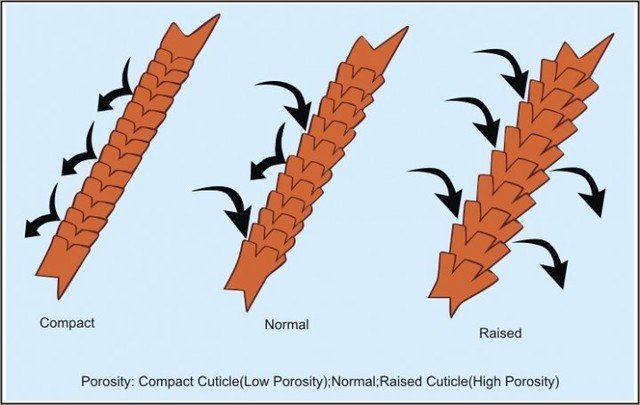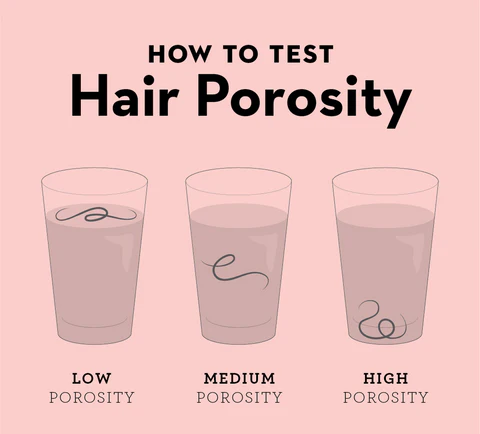Understanding Hair Porosity: Tests, Tips, and Care Routines
Hair porosity is a term that refers to your hair’s ability to absorb and retain moisture. Knowing your hair’s porosity is essential because it affects how your hair responds to moisture, products, and environmental factors. In this article, we’ll dive into what hair porosity is, how to determine your hair’s porosity level, and tips for caring for each porosity type. Plus, we’ll answer some commonly asked questions to make things even clearer!
What Is Hair Porosity?

Porosity measures how well your hair absorbs moisture. Each hair strand has a protective outer layer called the cuticle, which can either be tightly packed or loosely spaced. These cuticle gaps determine how much water and products can penetrate the hair shaft. Understanding this can help you figure out which hair care products are best for you.
Types of Hair Porosity
There are three main levels of hair porosity: low, medium, and high.
- Low Porosity Hair:
- Characteristics: In low porosity hair, the cuticle is tightly bound, making it difficult for moisture and products to penetrate. Water often beads up on the surface instead of being absorbed. The hair tends to feel heavy or weighed down when too much product is applied.
- Caring for Low Porosity Hair: Use lightweight, water-based products. Avoid heavy oils and butters as they tend to sit on the hair. Using heat (like a warm towel or a steamer) helps to open the cuticles and allow moisture in.
- Common Issues: Product buildup and difficulty absorbing moisture.
- Medium Porosity Hair (Normal Porosity):
- Characteristics: Medium porosity hair has a cuticle that is looser, allowing just the right amount of moisture to enter. This type of hair is typically easier to manage, and it holds styles well.
- Caring for Medium Porosity Hair: You don’t need to follow any special routine; just maintain a healthy balance of moisture and protein. Deep conditioning treatments can help keep the hair strong and healthy.
- Common Issues: Over time, medium porosity hair can become more porous due to environmental factors, such as excessive heat styling or chemical treatments.
- High Porosity Hair:
- Characteristics: In high porosity hair, the cuticles are spaced far apart, making it easy for moisture to enter but difficult to retain. This hair type is often the result of damage from heat, chemicals, or environmental exposure.
- Caring for High Porosity Hair: Use heavier creams, oils, and butters to lock in moisture. Protein treatments help to temporarily patch the gaps in the cuticle, making the hair stronger.
- Common Issues: Frizz, dryness, and hair that loses moisture quickly.
How to Test Your Hair’s Porosity
Several simple methods can help you determine your hair’s porosity at home.

The Float Test:
- Take a few strands of clean hair and place them in a glass of water. Let it sit for 2–4 minutes. If the hair floats, you have low porosity. If it sinks to the middle, you have medium porosity. If it sinks to the bottom, your hair is highly porous.
The Slip Test:
- Take a strand of hair and slide your fingers up from the ends to the roots. If it feels smooth, you have low porosity. If it feels bumpy or uneven, you likely have high porosity hair.
The Spray Test:
- Spray water on your hair and observe how it reacts. If the water beads up on the surface, you have low porosity hair. If your hair quickly absorbs the water, it is likely high porosity.
How Hair Porosity Affects Your Routine
Low Porosity Hair:
- Do’s: Use lighter, water-based products and apply heat to help open up the cuticles.
- Don’ts: Avoid heavy creams or oils that can cause product buildup. Stay away from too many proteins, as low porosity hair doesn’t need extra strengthening.
Medium Porosity Hair:
- Do’s: Continue with a balanced routine of moisture and protein. Deep condition regularly to maintain healthy strands.
- Don’ts: Don’t overdo it with protein treatments unless necessary.
High Porosity Hair:
- Do’s: Incorporate protein-rich products to repair damage, and use sealing oils to lock in moisture.
- Don’ts: Avoid heat styling and chemical treatments that can worsen the condition of your cuticles.
Causes of High Hair Porosity
High porosity hair is usually the result of damage, though some people naturally have more porous hair. The following factors can increase hair porosity:
- Heat Styling: Frequent use of heat tools, like flat irons and blow dryers, can damage the cuticle.
- Chemical Treatments: Coloring, perming, or relaxing hair can weaken the hair structure, making it more porous.
- Environmental Damage: UV rays, wind, and pollution can cause the hair cuticle to break down over time.
- Genetics: Some people naturally have more porous hair, often inherited from their parents.
Treating High Porosity Hair
If you have high porosity hair, the goal is to rebuild and protect the hair shaft. Here are some tips:
- Protein Treatments: These help fill in the gaps in the cuticle, strengthening the hair temporarily.
- Moisturizing Products: Use products with ingredients like shea butter, coconut oil, and aloe vera to hydrate and seal in moisture.
- Avoid Excessive Heat: Heat tools can cause further damage. Air dry your hair whenever possible.
- Seal the Cuticle: Use cold water when rinsing your hair, as this helps close the cuticles and locks in moisture.
Common Myths About Hair Porosity
- Myth: “Low porosity hair can’t be moisturized.”
- Truth: Low porosity hair can be moisturized; you just need to use lightweight products and apply heat to help open up the cuticle.
- Myth: “High porosity hair is always damaged.”
- Truth: While high porosity hair is often the result of damage, it can also be natural.
- Myth: “You only need to test your hair porosity once.”
- Truth: Hair porosity can change over time due to various factors like heat, treatments, or aging.
Frequently Asked Questions (FAQs)
Q1: How often should I test my hair’s porosity?
A: It’s good to check your hair’s porosity a few times a year or whenever you notice changes in how your hair reacts to products.
Q2: Can I improve my hair’s porosity?
A: Yes! You can improve the health of your hair and its porosity by avoiding heat and chemical treatments and incorporating moisture and protein treatments into your routine.
Q3: Why does my hair dry so quickly after a shower?
A: This could be a sign of high porosity hair. The cuticles may be damaged, allowing moisture to escape quickly.
Q4: How can I prevent product buildup on low porosity hair?
A: Use clarifying shampoos occasionally and stick to lightweight, water-based products.
Q5: Is hair porosity genetic?
A: Yes, hair porosity can be genetic, but it can also change over time due to environmental factors and hair treatments.
Conclusion
Understanding your hair’s porosity is key to creating a hair care routine that works best for you. Whether you have low, medium, or high porosity hair, choosing the right products and treatments can make all the difference. Test your hair, adjust your routine, and give your locks the care they deserve!



